Cricetinae Almighty: Stunt Hamsters
Stunt Hamsters was a product of the third Indie Game Jam, which placed 21 game developers in one room for four days to hammer out a bunch of experimental games. Each Indie Game Jam has been themed, and the theme of IGJ2 was “Physics in Gameplay”, or, more explicitly, “Physics must be good for something besides ragdolls and exploding crates!”
How to Play
The game’s readme.txt file describes the action as follows:
In this game, you will see cute, furry, ignitable hamsters fire out of cannons at fixed rates until the total number of hamsters for a level have been fired. You can click and drag the mouse on a cannon or other world object to spin it around. You can click and drag elsewhere, on hamsters, to suck them up and re-fire them out of the cannon. The goal is to get the required number of hamsters into the spinning purple vortex goal. On the simplest level, you just point the cannon at the goal. In the later levels, the task becomes more complicated.
You simply click on hamsters to remove them from the level. You’ll want to do this when the maximum concurrent number of hamsters is reached. There is no limit to how many total hamsters will spawn, and no time limit. The levels are more like puzzles; you need to figure out exactly which sequence of events is required to get the hamsters into the goal.
Hamster States
Hamsters have four states, essentially: normal, normal-on-fire, halved, and halved-on-fire. Of course, fire spreads. When a burning hamster touches non-burning hamsters, it sets them on fire. When large caches of unlit hamsters ignite, they explode and generate impulses on nearby objects. The water spout object in the playfield turns on-fire hamsters back into normal hamsters (including halved-on-fire hamsters).
The games’ puzzle elements rely on these states. Some stages require you build up a cache of normal hamsters, and then detonate them to push blocks out the way or push hamsters to the goal. On another stage–seen in the first part of the video–you need to cut hamsters into pieces to get them to the goal, then set them on fire in order to reconstitute the halves into normal hamsters again.
Simulation Management
What’s fun about Stunt Hamsters, to me, is that you’re managing a simulation of sorts. You don’t have any direct control over the hamsters’ motion. Instead, there are only a few objects to fiddle with. Typically you’ll make a few changes to the angles of the objects, observe the results, and then twiddle with the few variables you do control. Zeroing in on your imagined solution is very addictive. The closer you get, the more you’re sure things are going to work.
Physics Engine
Stunt Hamsters is powered by Atman Binstock’s 2D physics engine. The engine is optimized for stacking, which tends to make objects a little sticky. All collisions are inelastic, too; bouncing isn’t supported. Apparently these limitations initially caused a few design headaches during the game jam, until people became conscious of them and designed for the particular set of features.
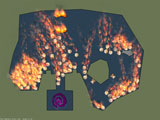
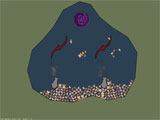
(Stunt Hamsters Game Screenshots)
A Note on the IGJ2 Games
There are a lot of other physics games available for download, although bear in mind that they were designed for PS2 dual shock controllers. Some games have no keyboard/mouse input, and you’ll need the identical PS2-to-USB converter as the developers to have the button mappings line up properly if you do have a controller lying around. Thankfully, Stunt Hamsters has mouse-only controls.
The source code for some of these games is available, too. Unfortunately, the physics engine code isn’t available, so you won’t actually be able to compile anything. Atman’s engine, along with the rest of the games’ code, was supposed to have been released under the GPL. I wouldn’t hold your breath, though; the event was two years ago.
Also, a Gamasutra article is available with some general post mortem-style information on IGJ2 itself.
Highly Trained, Indeed
Sadly, Stunt Hamsters only has a meager 7 levels to play. It’s a great proof of concept, and would certainly be enjoyable to play if it were made into a full product. Even still, it’s an amusing way to kill some time and a great example of a fun physics game.
Download Stunt Hamsters here (4.28MB), or head on over to the Indie Game Jam website for the rest of the physics games.
Related Posts:
- McTuble Releases Integrated Ski Stunt Editor
- List of Physics Games
- The Beginning
- Fun-Motion Exclusive: Ski Stunt Extreme
- A Brilliant Physics Game: Ski Stunt Simulator
Fowl Play: Kumoon
Kumoon by Mikko “Mayoneez” Oksalahti is a bizarre little game. It plays a bit like a physics demo with some rough goals slapped on top. Despite that, though, it’s actually a lot of fun. The official site describes the game as:
Kumoon is a hybrid of a third person shooter and a puzzle game. Player controls a chick that tries to knock down boxes in various rooms by shooting them with a revolver, shotgun or a bazooka.
Wait, What?
It’s a bizarre combination of play styles. The goal of the game is to turn all of the red boxes to white without incurring too many negative points. You turn the color of a box by jarring it, either with one of your weapons to by pushing something into it. Using your weapon, past the first free shot, will cost you points. Touching a red box will cost you points. You get points back by turning boxes white, which can be multiplied by bouncing a shot off something en route to its target.
Puzzle Elements
Despite its puzzle influences, Kumoon doesn’t resemble a logic game. Most of the stages play in a very free-form fashion. Instead of a single “correct” solution, you can change the blocks’ colors in any order you see fit. There are some rules you should apply, though. It’s best to start with higher blocks and leave low-lying blocks for last. It’s easy to push white blocks against red blocks on the ground.
The later levels introduce platforms, pedestals, and other means of isolating red blocks. Sometimes you really do need to use a weapon, which means you need to save up your points. I played through the game without doing a lot of combos, which made some weapon-heavy levels much harder than they could have been had I learned how to properly combo.
More Puzzle, Please
The last stage of the game is the only one that plays like a puzzle. It actually forces you to pass by scoring combos; you must figure out exactly where to bank your shots. It’s very billiards-esque mechanic. It was fun to figure out exactly where to shoot in order to pass the level (stand next to the pedestal and aim at the 7th line up on the wall). It makes me wish more of the game leaned into this style of play, aided additional features to easily tell where the last shots went: tracers, paint dabs on the wall where they bounced, predictive lines, etc.
Then again, the freedom in the game as it stands has a certain addictive quality to it. You could play through the game as a block-pusher, or figure out how to rack up points with combos, or meticulously set up physics domino sequences to get all of the red blocks. The game definitely supports a number of different play styles.
Physics Engine
Kumoon uses a custom physics engine written by the author, called MOPE. It’s an impressive effort for a one-man job. The physics perform very well, although it does seem like the engine has no concept of mass. The large objects tend to float and feel as if they weigh the same as the smaller objects.
Not Just for the Birds
Kumoon is totally free. It’s a great example of how physics games can take simple mechanics and turn them into a surprising amount of entertainment. The room setup files are in a documented format, too, so if you burn all 39 levels in one sitting there’s always the option to make some more. If you do, shoot me an email–I need more levels to play!
Download Kumoon game here (6.18 MB) or head over to the official website for more information and a MacOS build.
Related Posts:
Toybox: Why Buy New When Digital Will Do?
Toybox by Souptoys is a neat product. It isn’t exactly a game, in that you aren’t given any concrete goals. There’s nothing to accomplish; it’s a toy. Souptoys describes their product as:
Souptoys are the newest way to have fun on your computer. Sitting right alongside your other applications, Souptoys turn your desktop into a playroom. They are fun and simple to play with and have unlimited possibilities. Build great castles, set up fantastic contraptions, decorate your desktop or just fling your toys around. It’s your choice – They’re your toys!
Desktop Toy
Basically, Toybox is a collection of 60 different physics contraptions: Levers, balls, balloons, catapult, and so on. The application is a desktop toy in the sense that it doesn’t go full screen or have its own primary window. Instead, the toys have their own transparency and fit into the normal Windows drawing order.
Playsets
Toybox ships with 39 different pre-configured setups, called playsets. Some are fairly static, like castles and flower beds. Others are designed with interaction in mind. The video is captured from the “Target Practice”. It’s obviously set up so you can lob baseballs at the different toys set up across from the catapult. Of course, you could always pick up the blocks directly and smash things apart yourself.
You can save your own playset, which records the position of all of the objects. I didn’t see any way to manually edit the positions of things, though. For instance, you couldn’t place 10 balls hanging in the air and save that starting position as a playset (they would all fall to the ground before you could click the save button).
There are additional playsets available on their website, too, uploaded by other users. The process is a little cumbersome, unfortunately. Uploading and downloading new playsets should be handled in-application, particularly if they’re hoping to engage the casual user.
Lasting Fun?
Toybox is available with an Armadillo-controlled 60-minute trial period. Despite its technical uniqueness and plethora of options, I can’t really see myself playing with Toybox past those 60 minutes. I’m probably not representative of their market, but I crave just a little bit more–some kind of multiplayer, maybe, which would be worth the additional development. Or perhaps the addition of goal-direct minigames would keep me playing. As it stands, I fiddle around with things for a few minutes before I inevitably end up bored. I’m willing to admit that I simply lack the imagination necessary to play with toys.
Business Model
If you’re looking for inspiration for alternative business models, Toybox is a good example of something that completely breaks the mold of most downloadable games. If they’re able to improve their community features I think they’ll be able to slowly build a user base. And then, of course, sell expansion pack after expansion pack of new toys. I’m very curious to know if they’ve thought out their long-term business plan at all.
Try It Out!
Toybox is a great way to unwind, particularly if your real desk is far too cluttered to play with toys (or perhaps far too cluttered with toys). It’s a fun time waster, and clicking the X is certainly a lot faster than picking up after real toys.
Head over to Souptoys’ webpage to download the 60-minute Toybox demo (12.5 MB).
Related Posts:
« Previous Page — Next Page »


 (Rate this game! 103 votes, average: 3.70 out of 5)
(Rate this game! 103 votes, average: 3.70 out of 5)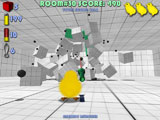
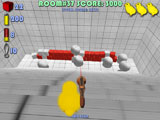
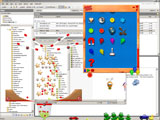
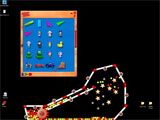
 My name is Matthew Wegner, and this site is dedicated to physics games.
My name is Matthew Wegner, and this site is dedicated to physics games.